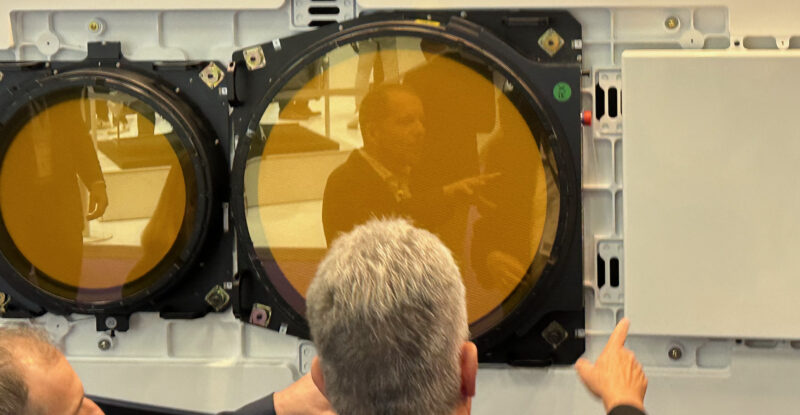At a time of massive disruption in inflight connectivity — colored by industry consolidation, the introduction of LEO satellite service to the GEO satellite mix initially in the Ku-band frequency, and a growing uncoupling of antenna hardware and service providers (giving airlines more choice) — there is a new would-be commercial aero ISP on the scene in the form of Germantown, Maryland-based satellite operator Hughes Network Systems.
Having announced a new global distribution partnership with OneWeb last week at the Aircraft Interiors Expo in Hamburg, Hughes vice president Reza Rasoulian shared additional color at the show, telling Runway Girl Network that Hughes is ready to go direct to airlines or through a select partner.
He said:
So we’ve made the decision to help the industry in whatever way makes sense, whether it’s to an airline or through a select partner, especially with our OneWeb distribution agreement in commercial aviation. There’s really a lot of opportunity to create value for the passenger and that’s really our goal.
In so doing, vertically-integrated Hughes will compete for aircraft tails in a commercial aviation market that already includes several heavy-hitters: Intelsat, Panasonic Avionics, Viasat (which has just started integrating newly acquired Inmarsat), and other aero ISPs.
Hughes will offer no fewer than three distinct IFC solutions to airlines:
Hughes LEO-only, via OneWeb’s Ku-band LEO satellite service, and as enabled by the Hughes electronically steerable antenna (ESA);
Hughes Jupiter In-flight, a high-throughput Ka-band GEO-now focused product in the Americas and beyond (with a path to Ka-band MEO and LEO in the future) using the popular ThinKom Solutions Ka2517 VICTS antenna or, for regional jets, ThinKom’s smaller Ka1717 (with Hughes’ Jupiter auxiliary modem unit); and, fascinatingly,
a Hughes Jupiter Fusion product whereby Hughes blends Ka-band GEO with OneWeb Ku-band LEO services in a multi-band, multi-orbit hybrid (which meshes with the vision shared by Hughes with RGN at Satellite 2023).
Hughes LEO-only
That Hughes is bringing a Hughes LEO-only IFC solution to commercial aviation using its own ESA makes sense. After all, the company is already working with Gogo Business Aviation to supply its ESA to the BizAv market as part of Gogo’s forthcoming new global OneWeb LEO and hybrid LEO satcom/air-to-ground (ATG) offering. The program is on target to flight-test the ESA in the second half of 2024.
Hughes’ entry into commercial aviation does not thread on its exclusive agreement with Gogo in business aviation. “We did that very deliberately and it was very open communication. They were not interested in commercial aviation, we obviously were. I think it was a great way of bringing our technology further into the aviation market,” explained Rasoulian to RGN.
“So you know, we’ll have thousands of business aircraft with our Hughes LEO antenna technology and hopefully thousands of commercial aircraft as well with the similar” Hughes LEO-only and LEO-augmenting-GEO technology.
Hughes Jupiter In-Flight
Regarding Hughes Jupiter In-Flight, your author has long wondered if Hughes would ultimately take a direct GEO approach to compete with Viasat in North America (and indeed, I’m guilty of asking the same question of Hughes for years!)
Given the North American footprint of Hughes’ current Jupiter, high-capacity Ka-band satellites, it seems logical to assume that this Ka-band GEO-supported solution will initially be focused on North America. But Rasoulian noted: “So you know, Jupiter is the de facto standard when it comes to the baseband technology we’re operating, and Hughes’ technology is operating in over 80 countries. We have Jupiter-enabled capacity over North and South America, Europe, Middle East.”
As such, Hughes has “the mobility roaming software that lets an aircraft seamlessly roam. So again, I think North and South America into Europe, Africa, Middle East, the Atlantic is fully illuminated by Jupiter capacity. And then again we have the option to add OneWeb [Ku-band LEO via the hybrid],” he added, which brings us to the third IFC product, the Hughes Jupiter Fusion multi-band (Ka- and Ku-band), multi-orbit (GEO and LEO) hybrid.
Hughes Jupiter Fusion
“It’s really a ‘no compromise’ solution because you’re getting the benefit of the capacity density of the Ka GEO, and the low latency of a OneWeb LEO Ku network, which is phenomenal,” said Rasoulian of the hybrid.
Notably, for new IFC installs, the hybrid will in fact be supported by ThinKom’s new ThinAir Plus mix-and-match package combining, in this instance, the Ka2517 VICTS talking to Ka GEO with Hughes’ ESA tucked beside it under the same radome (or positioned elsewhere atop the fuselage) talking to OneWeb, Rasoulian revealed to RGN at AIX.
The multi-band, multi-orbit hybrid was on display at ThinKom’s stand at AIX.
Rasoulian noted that Hughes is also “happy to work with partners” to augment existing GEO satellite-based IFC solutions — installed on the world fleet today — “and add our very small antenna system” with Hughes’ patented Fusion software “and really bring GEO and LEO together and we’re demonstrating this in Maryland as we speak”.
So, for existing installs, “frankly, any other antenna installation that’s flying today, we could augment with this [the ESA]. We’re a bit open, right,” he said.
Hughes is eyeing early 2025 for market entry in commercial aviation, starting with the retrofit market.













